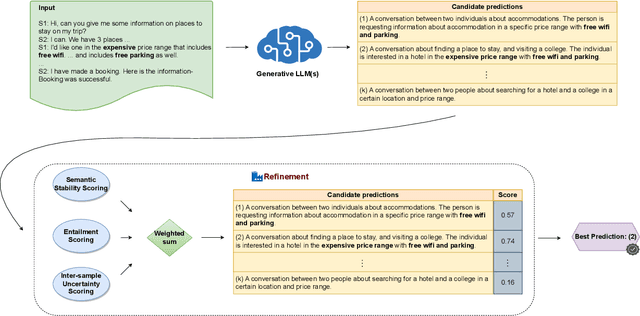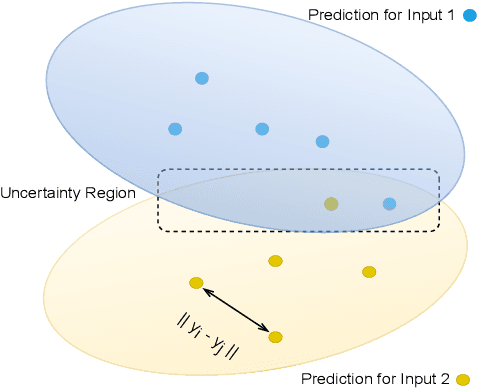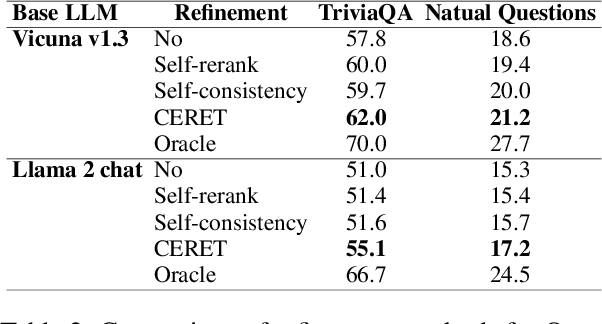Saab Mansour
PAARS: Persona Aligned Agentic Retail Shoppers
Mar 31, 2025Abstract:In e-commerce, behavioral data is collected for decision making which can be costly and slow. Simulation with LLM powered agents is emerging as a promising alternative for representing human population behavior. However, LLMs are known to exhibit certain biases, such as brand bias, review rating bias and limited representation of certain groups in the population, hence they need to be carefully benchmarked and aligned to user behavior. Ultimately, our goal is to synthesise an agent population and verify that it collectively approximates a real sample of humans. To this end, we propose a framework that: (i) creates synthetic shopping agents by automatically mining personas from anonymised historical shopping data, (ii) equips agents with retail-specific tools to synthesise shopping sessions and (iii) introduces a novel alignment suite measuring distributional differences between humans and shopping agents at the group (i.e. population) level rather than the traditional "individual" level. Experimental results demonstrate that using personas improves performance on the alignment suite, though a gap remains to human behaviour. We showcase an initial application of our framework for automated agentic A/B testing and compare the findings to human results. Finally, we discuss applications, limitations and challenges setting the stage for impactful future work.
MEMERAG: A Multilingual End-to-End Meta-Evaluation Benchmark for Retrieval Augmented Generation
Feb 25, 2025Abstract:Automatic evaluation of retrieval augmented generation (RAG) systems relies on fine-grained dimensions like faithfulness and relevance, as judged by expert human annotators. Meta-evaluation benchmarks support the development of automatic evaluators that correlate well with human judgement. However, existing benchmarks predominantly focus on English or use translated data, which fails to capture cultural nuances. A native approach provides a better representation of the end user experience. In this work, we develop a Multilingual End-to-end Meta-Evaluation RAG benchmark (MEMERAG). Our benchmark builds on the popular MIRACL dataset, using native-language questions and generating responses with diverse large language models (LLMs), which are then assessed by expert annotators for faithfulness and relevance. We describe our annotation process and show that it achieves high inter-annotator agreement. We then analyse the performance of the answer-generating LLMs across languages as per the human evaluators. Finally we apply the dataset to our main use-case which is to benchmark multilingual automatic evaluators (LLM-as-a-judge). We show that our benchmark can reliably identify improvements offered by advanced prompting techniques and LLMs. We will release our benchmark to support the community developing accurate evaluation methods for multilingual RAG systems.
GLEAN: Generalized Category Discovery with Diverse and Quality-Enhanced LLM Feedback
Feb 25, 2025Abstract:Generalized Category Discovery (GCD) is a practical and challenging open-world task that aims to recognize both known and novel categories in unlabeled data using limited labeled data from known categories. Due to the lack of supervision, previous GCD methods face significant challenges, such as difficulty in rectifying errors for confusing instances, and inability to effectively uncover and leverage the semantic meanings of discovered clusters. Therefore, additional annotations are usually required for real-world applicability. However, human annotation is extremely costly and inefficient. To address these issues, we propose GLEAN, a unified framework for generalized category discovery that actively learns from diverse and quality-enhanced LLM feedback. Our approach leverages three different types of LLM feedback to: (1) improve instance-level contrastive features, (2) generate category descriptions, and (3) align uncertain instances with LLM-selected category descriptions. Extensive experiments demonstrate the superior performance of \MethodName over state-of-the-art models across diverse datasets, metrics, and supervision settings. Our code is available at https://github.com/amazon-science/Glean.
Faithful, Unfaithful or Ambiguous? Multi-Agent Debate with Initial Stance for Summary Evaluation
Feb 12, 2025Abstract:Faithfulness evaluators based on large language models (LLMs) are often fooled by the fluency of the text and struggle with identifying errors in the summaries. We propose an approach to summary faithfulness evaluation in which multiple LLM-based agents are assigned initial stances (regardless of what their belief might be) and forced to come up with a reason to justify the imposed belief, thus engaging in a multi-round debate to reach an agreement. The uniformly distributed initial assignments result in a greater diversity of stances leading to more meaningful debates and ultimately more errors identified. Furthermore, by analyzing the recent faithfulness evaluation datasets, we observe that naturally, it is not always the case for a summary to be either faithful to the source document or not. We therefore introduce a new dimension, ambiguity, and a detailed taxonomy to identify such special cases. Experiments demonstrate our approach can help identify ambiguities, and have even a stronger performance on non-ambiguous summaries.
Hierarchical Multi-field Representations for Two-Stage E-commerce Retrieval
Jan 30, 2025



Abstract:Dense retrieval methods typically target unstructured text data represented as flat strings. However, e-commerce catalogs often include structured information across multiple fields, such as brand, title, and description, which contain important information potential for retrieval systems. We present Cascading Hierarchical Attention Retrieval Model (CHARM), a novel framework designed to encode structured product data into hierarchical field-level representations with progressively finer detail. Utilizing a novel block-triangular attention mechanism, our method captures the interdependencies between product fields in a specified hierarchy, yielding field-level representations and aggregated vectors suitable for fast and efficient retrieval. Combining both representations enables a two-stage retrieval pipeline, in which the aggregated vectors support initial candidate selection, while more expressive field-level representations facilitate precise fine-tuning for downstream ranking. Experiments on publicly available large-scale e-commerce datasets demonstrate that CHARM matches or outperforms state-of-the-art baselines. Our analysis highlights the framework's ability to align different queries with appropriate product fields, enhancing retrieval accuracy and explainability.
DFlow: Diverse Dialogue Flow Simulation with Large Language Models
Oct 18, 2024Abstract:Developing language model-based dialogue agents requires effective data to train models that can follow specific task logic. However, most existing data augmentation methods focus on increasing diversity in language, topics, or dialogue acts at the utterance level, largely neglecting a critical aspect of task logic diversity at the dialogue level. This paper proposes a novel data augmentation method designed to enhance the diversity of synthetic dialogues by focusing on task execution logic. Our method uses LLMs to generate decision tree-structured task plans, which enables the derivation of diverse dialogue trajectories for a given task. Each trajectory, referred to as a "dialog flow", guides the generation of a multi-turn dialogue that follows a unique trajectory. We apply this method to generate a task-oriented dialogue dataset comprising 3,886 dialogue flows across 15 different domains. We validate the effectiveness of this dataset using the next action prediction task, where models fine-tuned on our dataset outperform strong baselines, including GPT-4. Upon acceptance of this paper, we plan to release the code and data publicly.
Structured List-Grounded Question Answering
Oct 04, 2024Abstract:Document-grounded dialogue systems aim to answer user queries by leveraging external information. Previous studies have mainly focused on handling free-form documents, often overlooking structured data such as lists, which can represent a range of nuanced semantic relations. Motivated by the observation that even advanced language models like GPT-3.5 often miss semantic cues from lists, this paper aims to enhance question answering (QA) systems for better interpretation and use of structured lists. To this end, we introduce the LIST2QA dataset, a novel benchmark to evaluate the ability of QA systems to respond effectively using list information. This dataset is created from unlabeled customer service documents using language models and model-based filtering processes to enhance data quality, and can be used to fine-tune and evaluate QA models. Apart from directly generating responses through fine-tuned models, we further explore the explicit use of Intermediate Steps for Lists (ISL), aligning list items with user backgrounds to better reflect how humans interpret list items before generating responses. Our experimental results demonstrate that models trained on LIST2QA with our ISL approach outperform baselines across various metrics. Specifically, our fine-tuned Flan-T5-XL model shows increases of 3.1% in ROUGE-L, 4.6% in correctness, 4.5% in faithfulness, and 20.6% in completeness compared to models without applying filtering and the proposed ISL method.
Fine-grained, Multi-dimensional Summarization Evaluation with LLMs
Jul 09, 2024



Abstract:Automated evaluation is crucial for streamlining text summarization benchmarking and model development, given the costly and time-consuming nature of human evaluation. Traditional methods like ROUGE do not correlate well with human judgment, while recently proposed LLM-based metrics provide only summary-level assessment using Likert-scale scores. This limits deeper model analysis, e.g., we can only assign one hallucination score at the summary level, while at the sentence level, we can count sentences containing hallucinations. To remedy those limitations, we propose FineSurE, a fine-grained evaluator specifically tailored for the summarization task using large language models (LLMs). It also employs completeness and conciseness criteria, in addition to faithfulness, enabling multi-dimensional assessment. We compare various open-source and proprietary LLMs as backbones for FineSurE. In addition, we conduct extensive benchmarking of FineSurE against SOTA methods including NLI-, QA-, and LLM-based methods, showing improved performance especially on the completeness and conciseness dimensions. The code is available at https://github.com/DISL-Lab/FineSurE-ACL24.
FineSurE: Fine-grained Summarization Evaluation using LLMs
Jul 01, 2024



Abstract:Automated evaluation is crucial for streamlining text summarization benchmarking and model development, given the costly and time-consuming nature of human evaluation. Traditional methods like ROUGE do not correlate well with human judgment, while recently proposed LLM-based metrics provide only summary-level assessment using Likert-scale scores. This limits deeper model analysis, e.g., we can only assign one hallucination score at the summary level, while at the sentence level, we can count sentences containing hallucinations. To remedy those limitations, we propose FineSurE, a fine-grained evaluator specifically tailored for the summarization task using large language models (LLMs). It also employs completeness and conciseness criteria, in addition to faithfulness, enabling multi-dimensional assessment. We compare various open-source and proprietary LLMs as backbones for FineSurE. In addition, we conduct extensive benchmarking of FineSurE against SOTA methods including NLI-, QA-, and LLM-based methods, showing improved performance especially on the completeness and conciseness dimensions. The code is available at https://github.com/DISL-Lab/FineSurE-ACL24.
CERET: Cost-Effective Extrinsic Refinement for Text Generation
Jun 08, 2024



Abstract:Large Language Models (LLMs) are powerful models for generation tasks, but they may not generate good quality outputs in their first attempt. Apart from model fine-tuning, existing approaches to improve prediction accuracy and quality typically involve LLM self-improvement / self-reflection that incorporate feedback from models themselves. Despite their effectiveness, these methods are hindered by their high computational cost and lack of scalability. In this work, we propose CERET, a method for refining text generations by considering semantic stability, entailment and inter-sample uncertainty measures. Experimental results show that CERET outperforms Self-consistency and Self-rerank baselines consistently under various task setups, by ~1.6% in Rouge-1 for abstractive summarization and ~3.5% in hit rate for question answering. Compared to LLM Self-rerank method, our approach only requires 9.4% of its latency and is more cost-effective.
 Add to Chrome
Add to Chrome Add to Firefox
Add to Firefox Add to Edge
Add to Edge